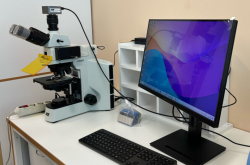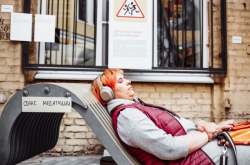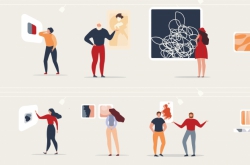The first Culture of the Future laboratory was organized by the project’s curator Olga Remnina in collaboration with Ivan Ninenko in Moscow this January. Ms Eremina is the head of the interdisciplinary program sector of the board of The National Centre for Contemporary Arts (NCCA) which is part of the ROSIZO exhibition center.
“During our first project, we wanted to tap into what the logic of art is about. That event, which was part of the “TECHNE. Preface” exhibition had little to do with technology. This time, we are going along with a more comprehensible, but still important concept: we study technologies and how the development of particular ones influences one’s perception of themselves and the Other. Also, we want to organize the process in such a way that we would get more practical results, and hope to witness some insightful multimedia projects,” comments Olga Remnina.
The event has already piqued the interest of many people; the amount of those who applied for participation has already exceeded the expected amount. As the entrance assignment, the participants have to answer the question “How does the inevitable development of technologies influence the perception of oneself and the Other?”, in any format they choose. Still, Olga Reminina underlines that the project’s curators selected participants as not just individuals, but people who will have to work as part of common processes.

The Laboratory’s workshops will be conducted in different formats. For instance, at ITMO University’s workshops, the participants will be told about particular technologies, so that the they would find it easier to imagine the world where these technologies have developed. What kinds of relations will exist at this point? Which values will be dominant? How would people perceive themselves in such a future? - these are the questions that the project’s participants will be looking for answers to.
“The Laboratory is sort of a prototype of what we are aiming to develop in St. Petersburg with the help of our Art&Science Master’s program. Yet, we still don’t know how St. Petersburg’s cultural community will react to it. We can’t forecast which ideas and projects will emerge from this laboratory, as it will bring together people who are interested in different kinds of projects: ecological, cultural protection, etc. There will be people with different outlook, different backgrounds. Do you remember the story with the Lakhta Center? There are both people who were against building a skyscraper in the city’s historic center and those who believed that the city shall move onwards and incorporate new architectural elements. There are many cultural spaces in our city that have left a mark on their regulars: places like Pushkinskaya 10, the New Holland, OkhtaLab, Etagi. There are many artistic communities in St. Petersburg that have to collaborate with each other, which is why our initiative - the new Master’s program and the Culture of the Future laboratory - is very relevant,” comments Anastasia Yarmosh, head of ITMO’s Art & Science Center.

ITMO.NEWS spoke to Anastasia and Olga about why St. Petersburg’s citizens don’t really associate themselves with the world of art, the importance of contemporary art projects for one’s development and will it happen so that special knowledge would once become necessary to perceive artistic ideas.
How are St. Petersburg’s artists’ communities different from those of Moscow?
Anastasia Yarmosh: In St. Petersburg, the artistic community is more restricted. Thus, we have a certain group of people who come to openings of exhibitions, but they only interact with each other. In Moscow, however, the communities of artists, musicians and directors are more flexible and open to communication. In this sense, Moscow is more forward-thinking than St. Petersburg. And this is exactly the reason why we want to make the Art&Science program an integration point for artistic projects which would attract artists and promote collaboration. In Moscow, people are also more open to changes in the urban environment, innovations; it is a multicultural city. St. Petersburg is a lot more tradition-bound.
How can one make it so that the works of St. Petersburg artists would be comprehensible to common people, so that they would not close off in their social circuit?
Anastasia Yarmosh: In St. Petersburg, this “closing off” is a long-standing issue. As for us, we want to create a more open cultural environment, and promote the dialog between not just the artists but artists and other people. To attain that, it is important that people themselves would understand that they are already involved in the cultural processes that happen in the city. For instance, you, as a journalist who writes an article about the Culture of the Future laboratory, are already involved.

Yet again, the relevance of art to the society depends on the artists, as well, i.e. whether they would think about the social meaning of their work and not just technological advances and the digital culture. Indeed, the point of contemporary art and culture is to show how modern technology influences our lives, and find ways to incorporate it and perceive them from an artistic point of view. What will the man of the future be like? The philosophy of the future in not selflessness but is rather focused on the person, on human values and lives.
What do you think is the main message that the art of the future shall confer? What should it teach people?
Anastasia Yarmosh: To think critically. Nowadays, we completely trust the data that we get from the information environment. People become hostage to this data, and no longer critically perceive the information they receive. As for artistic projects, those are irrational. They make us think why they are executed in one way and not another. This stimulates critical and analytical thinking which is essential for modern life. People shall not rely on reflexes only.

Will it become necessary to possess certain knowledge in the field of modern technology in order to understand art projects? And how about now?
Anastasia Yarmosh: Surely not. There is this Black Flags project by William Forsythe, for instance; you see black flags, and soulless machines that control them. The artist’s idea was to mimic the stage movements of a dance with the geometry of the black canvas; not just choreographers, but robotics specialists also participated in this project. The viewers can perceive the artwork as a vivid story associated with their particular cultural background. This means that everyone will perceive this installation depending on their emotional intelligence and thus train this kind of intelligence and critical thinking. Some may get an idea about how helpless we become without the help of robots. We are already almost incapable of living without smartphones. Others can get different ideas. Thus, it doesn't really matter how much a viewer knows about technology when they perceive the art of the future.
Another example is the “999 questions on contemporary living”, an art project exhibited in Milan. It is a black cube that contains 999 small displays; when you come inside, you see different scenes from people’s common lives. On the other side of the displays there are numbers that show how much energy such lifestyles consume. The project is dedicated to the issue of energy preservation. In the next room, there’s an exhibition which tells about modern technologies that contribute to environmental conservation. Thus, the project is a grand collaboration where viewers, artists, and engineers can work on the ideas of ecology and alternative sources of energy.
Do you think that such a program as Art&Science is really something in demand? Is it really necessary to educate people on this topic?
Anastasia Yarmosh: Of course it is, especially in the field of education. It was not so long ago that the concept of Art&Science has become a topic for discussion in Russia. Surely, there were certain secluded communities, but now we have to refocus this field towards the wider world. The new Master’s program, for one, is an attempt to attract public attention to this interdisciplinary field. I believe that in the coming three years, Art&Science will receive more and more recognition as an artistic movement in Russia, as new related exhibitions and cultural spaces will emerge. For this reason, we aim to use our Master’s program to bring together the leading experts in this field. In this sense, ITMO University is an ideal platform to launch such a program.
What will the Master’s students study as part of the new program? And what about their job prospects?
Anastasia Yarmosh: Contemporary art, modern philosophy and practical assignments will constitute a large part of the program, so that our students would not just create interesting projects but also learn to set the tone for visual communication, i.e. interact with the audience and encourage it to think critically. This is why they will also be taught the basics of professional data visualization. Such knowledge and experience will let them supervise projects, work at museums and design studios, including those focusing on industrial design, as many companies now change their products’ design with regard to new technologies.

Olga Remnina: It won’t be long before the program’s graduates would be sought-after in practically any field, as the future belongs to interdisciplinary practices and crossboundary thinking. This is exactly what Art&Science is about. There’s a report that my colleague, the project’s curator Ivan Ninenko co-authored, which is called the Skills of the Future. It analyzes the skills and competencies that we will be relevant in times to come.
Olga, being a visiting lecturer for two ITMO’s Master’s program in the coming year, tell us about the methods you’ll be using for teaching students. What are the main ideas you would like to promote to them?
Olga Remnina: I want to show them that we can sometimes use art to peek into the future; art has a sort of a “foresight mechanism” to itself. And we need to do that in order to know what to pay attention to today, so that we can “repair the things that have been broken”, as it is said in Laurie Anderson’s song “The dream before”. And I want to do that in a live dialog. I am certainly not the kind of lecturer who puts on a crown and pretends to have absolute knowledge. Still, seeing myself as a lifelong learner helps me learn alongside those whom I teach.





